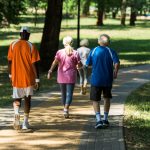
The impact of the COVID-19 pandemic on mental health is well-recognised, with the Centre for Mental Health estimating that up to 10 million people are likely to need some form of new or additional support as a result of the crisis (O’Shea, 2020). Consequently, this demand is overwhelming already saturated services in a time of austerity; for example, in the 12 months following the first national lockdown, Rethink Mental Illness reported a 175% increase in demand for their services (Tingle, 2022).
Depression is the leading cause of disability worldwide, with treatment options often favouring talking treatments and antidepressants (Molloy, 2023). However, the Royal College of Psychiatrists (2022) have reported that 23% of people wait more than 12 weeks to start treatment, with 43% of those reporting that their mental health deteriorates over this time. There is a clear need for alternative treatment options that are more accessible, and this is where exercise may come in.
After a long-documented history of anecdotal accounts and a steadily growing body of literature, exercise has now been added to the recommended treatment options for depression. To support this, researchers have been focusing on synthesising the literature to identify how effective exercise is for depression, and what would be most helpful to the everyday person. The evidence has been building over the last few years as is demonstrated by the growing number of elf blogs on exercise for depression. Adding to this initiative, Heissel and colleagues (2023) conducted an updated systematic review and meta-analysis on the effects of exercise in reducing clinical levels of depression in adults; described as “the largest synthesis of the effect of exercise on major depressive disorder (MDD) and depressive symptoms”. Additionally, they aimed to explore any factors that moderate an antidepressant effect and the presence of publication bias.

Exercise offers an accessible alternative to other treatments for depression, such as psychotherapy, which may have a long waiting list, but not everyone will find it easy to motivate themselves to exercise when they are depressed.
Methods
The authors searched 6 databases to find studies meeting the following eligibility criteria:
- Participants aged 18 years or older
- Primary diagnosis of Major Depressive Disorder (MDD), dysthymia, or depressive symptoms, determined by a validated screening measure
- Randomised controlled trials (RCTs) published in peer-reviewed journals
- Exercise used as the active intervention for depression
- Non-exercise control group
- Depressive symptoms measured pre- and post-intervention using validated depression scales.
The authors registered the study through PROSPERO and followed PRISMA guidelines. Independent reviewers screened the studies for eligibility as well as for assessing the quality of the studies using the Cochrane risk-of-bias tool for randomised trials, which found:
- 22 studies as high risk of bias
- 7 studies with some concerns
- 12 studies with low risk of bias.
A random effects meta-analysis was used, with effect sizes calculated as standardised mean difference (SMD). A linear meta-regression analysis was used to assess potential moderators for the anti-depressive effects of exercise. Finally, publication bias was assessed by visually inspecting funnel plots, and using Begg-Mazumdar Kendall’s tau and Eggar Bias test.
Results
Following screening and suitability checks, 41 studies were included in the meta-analysis.
The 41 studies contained 2,544 participants; of these, 2,264 completed treatments (1,227 in intervention groups and 1,037 in control groups). 21 of the included studies assessed for depressive symptoms through validated self-report measures, with the remaining 20 requiring a diagnosis of MDD. The percentage of female participants ranged from 26% to 100%, with mean ages ranging from 18.8 to 87.9 years.
Main findings:
- Overall SMD favoured exercise, demonstrating a large effect when compared to control groups (SMD = −0.946, 95% CI [−1.18 to −0.71]).
- When studies with a high risk of bias were removed, a moderate effect was found favouring exercise interventions (SMD = −0.717, 95% CI [−1.01 to −0.43]).
- Lastly, when studies with less than six weeks of intervention were removed, a large effect favouring exercise interventions were found (SMD = −0.959, 95% CI [−1.21 to −0.71]).
Subgroup analyses:
- Subgroup analysis indicated that the beneficial effect of exercise remained across all subgroup analyses, including depression classification, risk of bias, group exercise, supervised exercise, and trial sample size.
- Large effects were found for aerobic (SMD = -1.156, 95% CI [-1.46 to -0.85], p < .001) and resistance exercise (SMD = -1.042, 95% CI [-1.87 to -0.22], p = .013) but only small effects were found for mixed aerobic and resistance training (SMD = -0.455, 95% CI [-0.80 to -0.11], p = .009).
- Larger effects were also found in intervention arms with a group size of less than 25 people (SMD = -0.868, 95% CI [-1.11 to -0.63], p < .001, to SMD = -1.281, 95% CI [-1.87 to -0.70], p < .001) whereas larger samples of participants revealed moderate effects (SMD = -0.532, 95% CI [-0.81 to -0.26], p < .001,)
Meta-regression:
- In the meta-regression, shorter interventions were associated with larger effects (β = 0.032, 95% CI [0.01 to 0.09], p = .032, R² = 0.06).
- For MDD only, higher antidepressant use by the control group was associated with smaller effects (β = −0.013, 95% CI [−0.02 to −0.01], p = .012, R² = 0.28).
Numbers needed to treat (NNT):
- The calculated NNT was 2.0 (95% CI [1.68 to 2.59]), meaning that only two patients need to receive exercise (compared to the non-exercise control) for one person to benefit from it.
Adverse events:
- 10 studies reported no serious adverse events
- 3 studies reported minor events such as muscle or joint pain, headaches, and fatigue
- 1 study reported there was an adverse event, but did not provide further detail
- 3 studies reported side effects of worsening pre-existing orthopaedic injuries or an admittance to psychiatric ward due to MDD.

The meta-analysis found large effects for exercise in reducing symptoms of depression, with only 2 patients needing to receive ‘treatment’ for an effect to be seen.
Conclusions
This paper sought to provide an updated meta-analysis of the most recent research investigating the effects of exercise on depression. The reviewers should be commended for this important addition to our knowledge.
The authors suggest that:
Exercise is efficacious in treating depression and depressive symptoms and should be offered as an evidence-based treatment option focusing on supervised and group exercise with moderate intensity and aerobic exercise regimes.
The authors also concluded that, “results show moderate to large effects of exercise on depressive symptoms even when limiting the analysis to low risk of bias studies” and that “exercise is non-inferior to current first line treatments”. However, they also acknowledge the wide range of quality across the included studies, and that tests for publication bias actually indicated an underestimation of effect size.

This review suggests that exercise is non-inferior to current first line treatments (psychotherapy and medication), but we still need research to show that exercise is effective for treating depression in the long-term.
Strengths and limitations
Strengths
The authors did well to ensure that this study was of high quality, including pre-registering with PROSPERO and following PRISMA guidelines. The PICO framework was used to develop a thorough search criteria and a wide range of databases were searched. Their use of independent reviewers also lowered the chances of bias in their own results.
Personally, when I saw another paper looking at the effects of exercise on depression, I did admittedly think “do we need another one?”. However, the authors did well to highlight the need for this paper, correctly identifying the increase in depression since the COVID-19 pandemic and the flaws in current treatment options and study quality. Their results update our knowledge regarding the efficacy of exercise for depression by highlighting aspects of interventions that may make them more effective (e.g., being supervised).
The authors also completed an analysis that translated their results into NNTs (numbers needed to treat), which is a more understandable and meaningful statistic for clinical practice. They found that only two people need to receive exercise (versus a non-exercise control) for an effect to be seen, in comparison to an NNT of 2.5 for psychotherapy or 4.3 for medication (Cuijpers et al., 2020; Cipriani et al., 2018).
Note: an NNT of 2-5 is generally regarded to be indicative of an effective therapy. Find out more in this classic Bandolier page from the last century: Number needed to treat (NNT).
Limitations
Whilst I do really like this study, I found that after reading it, I still had a number of questions that the paper did not adequately answer:
- How can we be sure that it is exercise causing this effect? What struck me was that a lot (if not all) of these exercise interventions were completed in groups, and those with a supervisor saw stronger effects. These two findings in particular suggest that there could be an effect relating to the community aspect of exercise; however, this was not explored.
- Shorter interventions showed larger effects. Could this suggest a novelty effect? I am curious as to the longer-term effects of exercise as an antidepressant.
- Alternatively, it might depend on how much exercise an individual already does, which was also not considered in the analysis. The intervention could be more effective for those who do not already regularly exercise, meaning there is still a treatment gap for those who do exercise, but continue to struggle with depression.
Finally, I am cautious about the wording of these results when compared to first-line treatments, especially therapy. I don’t dispute the results of the paper, but anecdotally I feel like exercise would need to be recommended to the right person in the right headspace. I would therefore suggest caution when interpreting the results of the meta-analysis.

The meta-analysis is of high quality; however, some caution must be given when interpreting findings, as factors such as the longevity of effects and confounding factors were not considered.
Implications for practice
The high quality of this study means that we can be pretty confident (if we weren’t already) that exercise can have a positive effect on depression. I can see this paper having an impact in numerous areas:
- The paper helpfully identifies the Number Needed to Treat. At a system and government level, these results should be welcomed with opened arms for identifying an intervention for the most disabling condition in the world that is (1) largely positive, (2) potentially low cost, (3) socially acceptable, and (4) has minimal side-effects. Alongside the improvements for the person’s physical health. Wouldn’t it be great to see discounted (or free) sports membership, classes or equipment for those struggling with depression?
- I see this paper as bringing confidence to clinicians prescribing exercise for depression, so that they do not feel like they are providing a sub-optimal treatment to someone who is struggling.
- This paper is also well-timed in the context of the NHS reform to think about how social prescribing can be used as a frontline treatment.
However, thinking of how a patient might receive a prescription for a weekly exercise session would need to be considered. For someone struggling with depression, finding the motivation to leave their home and engage in these activities can be a real challenge. Additionally, patients might feel disappointed if they are expecting a therapeutic intervention, and instead receive a suggestion of exercise. I would like to see these exercise initiatives used in tandem with other interventions, such as medication or therapy.

This paper provides further confidence and evidence for the inclusion of exercise as a treatment for depression. However, consideration must be given to the person being recommended an exercise intervention, and whether it will meet their needs.
Statement of interests
Exercise advocate and practitioner.
Links
Heissel, A., Heinen, D., Brokmeier, L. L., Skarabis, N., Kangas, M., Vancampfort, D., … & Schuch, F. (2023). Exercise as medicine for depressive symptoms? A systematic review and meta-analysis with meta-regression. British Journal of Sports Medicine.
Other references
Cipriani, A., Furukawa, T. A., Salanti, G., Chaimani, A., Atkinson, L. Z., Ogawa, Y., … & Geddes, J. R. (2018). Comparative efficacy and acceptability of 21 antidepressant drugs for the acute treatment of adults with major depressive disorder: a systematic review and network meta-analysis. The Lancet, 391(10128), 1357-1366.
Cuijpers, P., Karyotaki, E., Eckshtain, D., Ng, M. Y., Corteselli, K. A., Noma, H., … & Weisz, J. R. (2020). Psychotherapy for depression across different age groups: a systematic review and meta-analysis. JAMA Psychiatry, 77(7), 694-702.
Molloy, A. (2023). Depression in adults: screening, treatment and management. Pharmaceutical Journal, June 2022.
O’Shea, N. (2020). Covid-19 and the nation’s mental health. October, 05–15.
Royal College of Psychiatrists. (2022). Hidden waits force more than three quarters of mental health patients to seek help from emergency services.
Tingle, J. (2011). The state of health care and adult social care in England. British Journal of Nursing, 20(12), 760-761.
Photo credits
- Photo by Bruno Nascimento on Unsplash
- Photo by Jonathan Borba on Unsplash
- Photo by Jozsef Hocza on Unsplash
- Photo by Anupam Mahapatra on Unsplash
- Photo by Elena Kloppenburg on Unsplash
- Photo by kike vega on Unsplash

Thanks for making this information so accessible and easy to understand 👍
We have a freely available NHS physical activity intervention which has been found to be effective in patients seen by depression and early intervention psychosis (EIP) services called ‘Well-Track’ see link: https://www.nhft.nhs.uk/research/